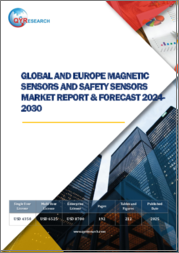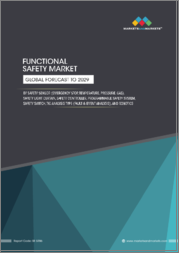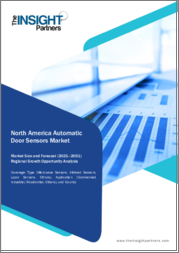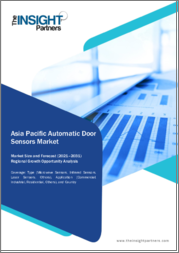
|
시장보고서
상품코드
1596308
안전 센서 시장 : 유형별, 센서 유형별, 용도별, 최종사용자별 - 세계 예측(2025-2030년)Safety Sensors Market by Type (Safety Edge, Safety Laser Scanner, Safety Light Curtain), Sensor Type (Accelerometers, Biosensors, Image Sensors), Application, End-User - Global Forecast 2025-2030 |
||||||
안전 센서 시장은 2023년에 6억 1,889만으로 평가되어 2024년에는 6억 6,128만 달러에 이를 것으로 예측되며, CAGR 6.92%로 성장하여 2030년에는 9억 8,869만 달러에 달할 전망입니다.
안전 센서는 자동차, 산업 자동화, 항공우주, 의료, 소비자 가전 등 다양한 산업에서 기계의 안전한 작동과 인명 보호를 보장하는 중요한 구성 요소입니다. 이 센서는 물리적 존재를 감지하고 시스템 상태를 모니터링하며 잠재적인 위험을 운전자에게 경고합니다. 엄격한 안전 규정과 자동화 기술의 채택 증가로 인해 안전 센서에 대한 수요가 크게 증가하고 있습니다. 주요 성장 요인으로는 민감도 및 신뢰성 향상과 같은 센서 기술의 발전, 예지보전을 위한 IoT 기기와의 통합, 작업장 안전에 대한 인식 증가 등을 들 수 있습니다. 또한, 전기차와 자율주행차 생산의 급증은 첨단 센서 기술에 대한 의존도가 높기 때문에 시장 확대의 큰 기회로 작용하고 있습니다. 높은 초기 비용, 기술의 복잡성, 정기적인 유지보수의 필요성 등은 시장 성장을 저해하는 요인으로 작용할 수 있습니다. 또한, 기존 시스템에 센서를 통합하기 위해서는 상당한 재설계와 투자가 필요할 수 있어 보급에 걸림돌이 될 수 있습니다. 이러한 과제에도 불구하고, 안전 센서는 에너지 효율과 보안에 기여하는 스마트 인프라, 환자 모니터링 시스템을 강화하는 헬스케어 등의 분야에서 유망한 기회를 제공합니다. 시장 개척은 자체 교정 및 무선 연결과 같은 기능이 강화된 비용 효율적인 센서 개발에 집중함으로써 시장 침투를 강화할 수 있습니다. 센서 용도의 의사결정을 위해 AI와 머신러닝에 중점을 두는 것도 잠재력을 가지고 있습니다. 기업들은 새로운 산업용도에 원활하게 통합될 수 있는 최첨단 센서 솔루션을 개발하기 위해 연구개발에 투자해야 합니다. 시장은 기술 발전과 규제의 발전으로 역동적으로 변화하고 있으며, 기업은 안전 센서 분야의 새로운 트렌드와 혁신을 활용하기 위해 민첩하고 선구적인 태도를 유지해야 합니다.
| 주요 시장 통계 | |
|---|---|
| 기준 연도(2023) | 6억 1,889만 달러 |
| 예측 연도(2024년) | 6억 6,128만 달러 |
| 예측 연도(2030년) | 9억 8,869만 달러 |
| CAGR(%) | 6.92% |
시장 역학: 빠르게 진화하는 안전 센서 시장의 주요 시장 인사이트 공개
안전 센서 시장은 수요 및 공급의 역동적인 상호작용에 의해 변화하고 있습니다. 이러한 시장 역학의 진화를 이해함으로써 기업은 정보에 입각한 투자 결정, 전략적 의사결정, 새로운 비즈니스 기회를 포착할 수 있습니다. 이러한 트렌드를 종합적으로 파악함으로써 기업은 정치적, 지리적, 기술적, 사회적, 경제적 영역에 걸친 다양한 리스크를 완화하고, 소비자 행동과 그것이 제조 비용 및 구매 동향에 미치는 영향을 보다 명확하게 이해할 수 있습니다.
- 시장 성장 촉진요인
- 제조업의 근로자 안전에 대한 인식이 높아지고 있습니다.
- 직장 안전에 관한 정부 규정
- 첨단 안전 기술에 대한 수요 증가
- 시장 성장 억제요인
- 안전센서 설치비용이 높습니다.
- 시장 기회
- 안전 센서의 급속한 기술 진보 및 발전
- 사고와 부상으로부터 직원을 보호하기 위한 안전 장비와 기술에 대한 투자
- 시장 과제
- 기계 안전의 중요성에 대한 인식 부족
Portre's Five Forces: 안전센서 시장 공략을 위한 전략 도구
Portre's Five Forces 프레임워크는 시장 상황경쟁 구도를 이해하는 중요한 도구입니다. Portre's Five Forces 프레임워크는 기업의 경쟁력을 평가하고 전략적 기회를 탐색할 수 있는 명확한 방법을 제공합니다. 이 프레임워크는 기업이 시장 내 세력도를 평가하고 신규 사업의 수익성을 판단하는 데 도움이 됩니다. 이러한 통찰력을 통해 기업은 강점을 활용하고, 약점을 해결하고, 잠재적인 도전을 피하고, 보다 강력한 시장 포지셔닝을 확보할 수 있습니다.
PESTLE 분석 : 안전 센서 시장의 외부 영향 파악
외부 거시 환경 요인은 안전 센서 시장의 성과 역학을 형성하는 데 매우 중요한 역할을 합니다. 정치적, 경제적, 사회적, 기술적, 법적, 환경적 요인에 대한 분석은 이러한 영향을 탐색하는 데 필요한 정보를 제공하며, PESTLE 요인을 조사함으로써 기업은 잠재적 위험과 기회를 더 잘 이해할 수 있습니다. 이러한 분석을 통해 기업은 규제, 소비자 선호도, 경제 동향의 변화를 예측하고 선제적이고 능동적인 의사결정을 내릴 준비를 할 수 있습니다.
시장 점유율 분석 안전센서 시장 경쟁상황 파악
안전 센서 시장의 상세한 시장 점유율 분석을 통해 공급업체의 성과를 종합적으로 평가할 수 있습니다. 기업은 수익, 고객 기반, 성장률과 같은 주요 지표를 비교하여 경쟁적 위치를 파악할 수 있습니다. 이 분석은 시장의 집중화, 단편화, 통합의 추세를 파악할 수 있으며, 공급업체는 치열한 경쟁 속에서 자신의 입지를 강화할 수 있는 전략적 의사결정을 내리는 데 필요한 통찰력을 얻을 수 있습니다.
FPNV 포지셔닝 매트릭스 안전 센서 시장에서공급업체 성과 평가
FPNV 포지셔닝 매트릭스는 안전 센서 시장에서 벤더를 평가하는 중요한 도구입니다. 이 매트릭스를 통해 비즈니스 조직은 벤더의 비즈니스 전략과 제품 만족도를 기반으로 평가하여 목표에 부합하는 정보에 입각한 의사결정을 내릴 수 있으며, 4개의 사분면으로 벤더를 명확하고 정확하게 세분화하여 전략 목표에 가장 적합한 파트너와 솔루션을 식별할 수 있습니다. 전략 목표에 가장 적합한 파트너와 솔루션을 식별할 수 있습니다.
안전센서 시장에서 성공하기 위한 전략 분석 및 추천 안전센서 시장에서의 성공 경로를 그립니다.
안전 센서 시장 전략 분석은 세계 시장에서 입지를 강화하고자 하는 기업에게 필수적입니다. 주요 자원, 역량 및 성과 지표를 검토함으로써 기업은 성장 기회를 식별하고 개선할 수 있습니다. 이러한 접근 방식을 통해 경쟁 환경의 도전을 극복하고 새로운 비즈니스 기회를 활용하여 장기적인 성공을 거둘 수 있도록 준비할 수 있습니다.
이 보고서는 주요 관심 분야를 포괄하는 시장에 대한 종합적인 분석을 제공합니다.
1. 시장 침투도 : 현재 시장 환경의 상세한 검토, 주요 기업의 광범위한 데이터, 시장 도달 범위 및 전반적인 영향력 평가.
2. 시장 개척도: 신흥 시장에서의 성장 기회를 파악하고, 기존 분야의 확장 가능성을 평가하며, 미래 성장을 위한 전략적 로드맵을 제공합니다.
3. 시장 다각화 : 최근 제품 출시, 미개척 지역, 업계의 주요 발전, 시장을 형성하는 전략적 투자를 분석합니다.
4. 경쟁 평가 및 정보 : 경쟁 구도를 철저히 분석하여 시장 점유율, 사업 전략, 제품 포트폴리오, 인증, 규제 당국의 승인, 특허 동향, 주요 기업의 기술 발전 등을 검토합니다.
5. 제품 개발 및 혁신 : 미래 시장 성장을 가속할 것으로 예상되는 첨단 기술, 연구 개발 활동 및 제품 혁신을 강조합니다.
이해관계자들이 충분한 정보를 바탕으로 의사결정을 내릴 수 있도록 다음과 같은 중요한 질문에 대한 답변도 제공합니다.
1. 현재 시장 규모와 향후 성장 전망은?
2. 최고의 투자 기회를 제공하는 제품, 부문, 지역은?
3. 시장을 형성하는 주요 기술 동향과 규제의 영향은?
4. 주요 벤더의 시장 점유율과 경쟁 포지션은?
5.벤더 시장 진입 및 철수 전략의 원동력이 되는 수익원과 전략적 기회는 무엇인가?
목차
제1장 서문
제2장 조사 방법
제3장 주요 요약
제4장 시장 개요
제5장 시장 인사이트
- 시장 역학
- 성장 촉진요인
- 성장 억제요인
- 기회
- 과제
- 시장 세분화 분석
- Porter's Five Forces 분석
- PESTEL 분석
- 정치
- 경제
- 사회
- 기술
- 법률
- 환경
제6장 안전 센서 시장 : 유형별
- 세이프티 엣지
- 안전 레이저 스캐너
- 안전 라이트 커튼
- 안전 매트
제7장 안전 센서 시장 : 센서 유형별
- 가속도계
- 바이오 센서
- 이미지 센서
- 모션 검출기
제8장 안전 센서 시장 : 용도별
- 자동 조립 스테이션
- 자동 포장 라인
- 자동 납땜 라인
- 자동 스탬핑 라인
- 자동 저장 시스템
- 금속 표면 치료 기계
- 경계 보호
- 펀치 및 프레스기
- 전단기
제9장 안전 센서 시장 : 최종사용자별
- 건설
- 방위
- 식품 및 음료
- 헬스케어
- 물류
- 제조업
- 광업
- 석유 및 가스
제10장 아메리카의 안전 센서 시장
- 아르헨티나
- 브라질
- 캐나다
- 멕시코
- 미국
제11장 아시아태평양의 안전 센서 시장
- 호주
- 중국
- 인도
- 인도네시아
- 일본
- 말레이시아
- 필리핀
- 싱가포르
- 한국
- 대만
- 태국
- 베트남
제12장 유럽, 중동 및 아프리카의 안전 센서 시장
- 덴마크
- 이집트
- 핀란드
- 프랑스
- 독일
- 이스라엘
- 이탈리아
- 네덜란드
- 나이지리아
- 노르웨이
- 폴란드
- 카타르
- 러시아
- 사우디아라비아
- 남아프리카공화국
- 스페인
- 스웨덴
- 스위스
- 터키
- 아랍에미리트(UAE)
- 영국
제13장 경쟁 구도
- 시장 점유율 분석, 2023년
- FPNV 포지셔닝 매트릭스, 2023년
- 경쟁 시나리오 분석
- 전략 분석과 제안
기업 리스트
- ABB Ltd.
- Chamberlain Group
- China Security & Fire IoT Sensing Co., Ltd.
- Datalogic S.p.A.
- GZ Cyndar Co., Ltd.
- Keyence Corporation
- Nanjing Wotian Tech. Co., Ltd.
- Olea Systems, Incorporated
- Omron Corporation
- Optex Fa Co., Ltd.
- Panasonic Industrial Devices
- Pepperl+Fuchs SE
- Pilz GmbH & Co. KG
- Pizzato Elettrica S.r.l.
- Rockwell Automation Inc.
- S.R.I Electronics
- Schmersal, Inc.
- Schneider Electric SE
- Sensata Technologies, Inc.
- SensoPart Industriesensorik GmbH
- SICK AG
- SoftNoze USA Inc
- TM Automation Instruments Co., Ltd.
- TSM Sensors s.r.l.
- Turck, Inc.
The Safety Sensors Market was valued at USD 618.89 million in 2023, expected to reach USD 661.28 million in 2024, and is projected to grow at a CAGR of 6.92%, to USD 988.69 million by 2030.
Safety sensors are critical components across various industries, including automotive, industrial automation, aerospace, healthcare, and consumer electronics, where they ensure the safe operation of machinery and the protection of human life. These sensors detect physical presence, monitor system status, and alert operators to potential hazards, making them indispensable in reducing accidents and enhancing operational efficiency. Driven by stringent safety regulations and the increasing adoption of automation technologies, the demand for safety sensors has grown substantially. Key growth influencers include advancements in sensor technology, such as improved sensitivity and reliability, integration with IoT devices for predictive maintenance, and rising awareness about workplace safety. Moreover, the surge in electric and autonomous vehicle production represents a significant opportunity for market expansion, as these vehicles rely heavily on advanced sensor technologies. Challenges such as high initial costs, technological complexity, and the need for regular maintenance can impede market growth. Additionally, integrating sensors into existing systems may require significant redesign and investment, posing a barrier to widespread adoption. Despite these challenges, safety sensors offer promising opportunities in areas like smart infrastructure, where they contribute to energy efficiency and security, and healthcare, where they enhance patient monitoring systems. Innovation can be focused on developing cost-effective sensors with enhanced capabilities, such as self-calibration and wireless connectivity, to bolster market penetration. Emphasis on AI and machine learning for decision-making in sensor applications also holds potential. Businesses should invest in R&D to pioneer cutting-edge sensor solutions that can be integrated seamlessly into new industrial applications. The market is dynamic, driven by technological advancements and regulatory developments, requiring businesses to remain agile and forward-thinking to capitalize on emerging trends and innovations in the safety sensors domain.
KEY MARKET STATISTICS Base Year [2023] USD 618.89 million Estimated Year [2024] USD 661.28 million Forecast Year [2030] USD 988.69 million CAGR (%) 6.92% Market Dynamics: Unveiling Key Market Insights in the Rapidly Evolving Safety Sensors Market
The Safety Sensors Market is undergoing transformative changes driven by a dynamic interplay of supply and demand factors. Understanding these evolving market dynamics prepares business organizations to make informed investment decisions, refine strategic decisions, and seize new opportunities. By gaining a comprehensive view of these trends, business organizations can mitigate various risks across political, geographic, technical, social, and economic domains while also gaining a clearer understanding of consumer behavior and its impact on manufacturing costs and purchasing trends.
- Market Drivers
- Growing awareness for the safety of workers in the manufacturing industry
- Government regulation for safety at the workplace
- Increase in demand for advanced safety technologies
- Market Restraints
- High installation charge for safety sensors
- Market Opportunities
- Rapid technological advancements and developments in safety sensors
- Investments in safety equipment and technologies to protect employees from accidents and injuries
- Market Challenges
- Lack of awareness regarding the importance of machine safety
Porter's Five Forces: A Strategic Tool for Navigating the Safety Sensors Market
Porter's five forces framework is a critical tool for understanding the competitive landscape of the Safety Sensors Market. It offers business organizations with a clear methodology for evaluating their competitive positioning and exploring strategic opportunities. This framework helps businesses assess the power dynamics within the market and determine the profitability of new ventures. With these insights, business organizations can leverage their strengths, address weaknesses, and avoid potential challenges, ensuring a more resilient market positioning.
PESTLE Analysis: Navigating External Influences in the Safety Sensors Market
External macro-environmental factors play a pivotal role in shaping the performance dynamics of the Safety Sensors Market. Political, Economic, Social, Technological, Legal, and Environmental factors analysis provides the necessary information to navigate these influences. By examining PESTLE factors, businesses can better understand potential risks and opportunities. This analysis enables business organizations to anticipate changes in regulations, consumer preferences, and economic trends, ensuring they are prepared to make proactive, forward-thinking decisions.
Market Share Analysis: Understanding the Competitive Landscape in the Safety Sensors Market
A detailed market share analysis in the Safety Sensors Market provides a comprehensive assessment of vendors' performance. Companies can identify their competitive positioning by comparing key metrics, including revenue, customer base, and growth rates. This analysis highlights market concentration, fragmentation, and trends in consolidation, offering vendors the insights required to make strategic decisions that enhance their position in an increasingly competitive landscape.
FPNV Positioning Matrix: Evaluating Vendors' Performance in the Safety Sensors Market
The Forefront, Pathfinder, Niche, Vital (FPNV) Positioning Matrix is a critical tool for evaluating vendors within the Safety Sensors Market. This matrix enables business organizations to make well-informed decisions that align with their goals by assessing vendors based on their business strategy and product satisfaction. The four quadrants provide a clear and precise segmentation of vendors, helping users identify the right partners and solutions that best fit their strategic objectives.
Strategy Analysis & Recommendation: Charting a Path to Success in the Safety Sensors Market
A strategic analysis of the Safety Sensors Market is essential for businesses looking to strengthen their global market presence. By reviewing key resources, capabilities, and performance indicators, business organizations can identify growth opportunities and work toward improvement. This approach helps businesses navigate challenges in the competitive landscape and ensures they are well-positioned to capitalize on newer opportunities and drive long-term success.
Key Company Profiles
The report delves into recent significant developments in the Safety Sensors Market, highlighting leading vendors and their innovative profiles. These include ABB Ltd., Chamberlain Group, China Security & Fire IoT Sensing Co., Ltd., Datalogic S.p.A., GZ Cyndar Co., Ltd., Keyence Corporation, Nanjing Wotian Tech. Co., Ltd., Olea Systems, Incorporated, Omron Corporation, Optex Fa Co., Ltd., Panasonic Industrial Devices, Pepperl+Fuchs SE, Pilz GmbH & Co. KG, Pizzato Elettrica S.r.l., Rockwell Automation Inc., S.R.I Electronics, Schmersal, Inc., Schneider Electric SE, Sensata Technologies, Inc., SensoPart Industriesensorik GmbH, SICK AG, SoftNoze USA Inc, TM Automation Instruments Co., Ltd., TSM Sensors s.r.l., and Turck, Inc..
Market Segmentation & Coverage
This research report categorizes the Safety Sensors Market to forecast the revenues and analyze trends in each of the following sub-markets:
- Based on Type, market is studied across Safety Edge, Safety Laser Scanner, Safety Light Curtain, and Safety Mat.
- Based on Sensor Type, market is studied across Accelerometers, Biosensors, Image Sensors, and Motion Detectors.
- Based on Application, market is studied across Automated Assembly Station, Automated Packing Line, Automated Soldering Line, Automated Stanping Line, Automated Storage System, Metal Surface Treatment Machines, Perimeter Protection, Punch & Press Machines, and Shearing Machines.
- Based on End-User, market is studied across Construction, Defense, Food & Beverages, Healthcare, Logistics, Manufacturing, Mining, and Oil & Gas.
- Based on Region, market is studied across Americas, Asia-Pacific, and Europe, Middle East & Africa. The Americas is further studied across Argentina, Brazil, Canada, Mexico, and United States. The United States is further studied across California, Florida, Illinois, New York, Ohio, Pennsylvania, and Texas. The Asia-Pacific is further studied across Australia, China, India, Indonesia, Japan, Malaysia, Philippines, Singapore, South Korea, Taiwan, Thailand, and Vietnam. The Europe, Middle East & Africa is further studied across Denmark, Egypt, Finland, France, Germany, Israel, Italy, Netherlands, Nigeria, Norway, Poland, Qatar, Russia, Saudi Arabia, South Africa, Spain, Sweden, Switzerland, Turkey, United Arab Emirates, and United Kingdom.
The report offers a comprehensive analysis of the market, covering key focus areas:
1. Market Penetration: A detailed review of the current market environment, including extensive data from top industry players, evaluating their market reach and overall influence.
2. Market Development: Identifies growth opportunities in emerging markets and assesses expansion potential in established sectors, providing a strategic roadmap for future growth.
3. Market Diversification: Analyzes recent product launches, untapped geographic regions, major industry advancements, and strategic investments reshaping the market.
4. Competitive Assessment & Intelligence: Provides a thorough analysis of the competitive landscape, examining market share, business strategies, product portfolios, certifications, regulatory approvals, patent trends, and technological advancements of key players.
5. Product Development & Innovation: Highlights cutting-edge technologies, R&D activities, and product innovations expected to drive future market growth.
The report also answers critical questions to aid stakeholders in making informed decisions:
1. What is the current market size, and what is the forecasted growth?
2. Which products, segments, and regions offer the best investment opportunities?
3. What are the key technology trends and regulatory influences shaping the market?
4. How do leading vendors rank in terms of market share and competitive positioning?
5. What revenue sources and strategic opportunities drive vendors' market entry or exit strategies?
Table of Contents
1. Preface
- 1.1. Objectives of the Study
- 1.2. Market Segmentation & Coverage
- 1.3. Years Considered for the Study
- 1.4. Currency & Pricing
- 1.5. Language
- 1.6. Stakeholders
2. Research Methodology
- 2.1. Define: Research Objective
- 2.2. Determine: Research Design
- 2.3. Prepare: Research Instrument
- 2.4. Collect: Data Source
- 2.5. Analyze: Data Interpretation
- 2.6. Formulate: Data Verification
- 2.7. Publish: Research Report
- 2.8. Repeat: Report Update
3. Executive Summary
4. Market Overview
5. Market Insights
- 5.1. Market Dynamics
- 5.1.1. Drivers
- 5.1.1.1. Growing awareness for the safety of workers in the manufacturing industry
- 5.1.1.2. Government regulation for safety at the workplace
- 5.1.1.3. Increase in demand for advanced safety technologies
- 5.1.2. Restraints
- 5.1.2.1. High installation charge for safety sensors
- 5.1.3. Opportunities
- 5.1.3.1. Rapid technological advancements and developments in safety sensors
- 5.1.3.2. Investments in safety equipment and technologies to protect employees from accidents and injuries
- 5.1.4. Challenges
- 5.1.4.1. Lack of awareness regarding the importance of machine safety
- 5.1.1. Drivers
- 5.2. Market Segmentation Analysis
- 5.3. Porter's Five Forces Analysis
- 5.3.1. Threat of New Entrants
- 5.3.2. Threat of Substitutes
- 5.3.3. Bargaining Power of Customers
- 5.3.4. Bargaining Power of Suppliers
- 5.3.5. Industry Rivalry
- 5.4. PESTLE Analysis
- 5.4.1. Political
- 5.4.2. Economic
- 5.4.3. Social
- 5.4.4. Technological
- 5.4.5. Legal
- 5.4.6. Environmental
6. Safety Sensors Market, by Type
- 6.1. Introduction
- 6.2. Safety Edge
- 6.3. Safety Laser Scanner
- 6.4. Safety Light Curtain
- 6.5. Safety Mat
7. Safety Sensors Market, by Sensor Type
- 7.1. Introduction
- 7.2. Accelerometers
- 7.3. Biosensors
- 7.4. Image Sensors
- 7.5. Motion Detectors
8. Safety Sensors Market, by Application
- 8.1. Introduction
- 8.2. Automated Assembly Station
- 8.3. Automated Packing Line
- 8.4. Automated Soldering Line
- 8.5. Automated Stanping Line
- 8.6. Automated Storage System
- 8.7. Metal Surface Treatment Machines
- 8.8. Perimeter Protection
- 8.9. Punch & Press Machines
- 8.10. Shearing Machines
9. Safety Sensors Market, by End-User
- 9.1. Introduction
- 9.2. Construction
- 9.3. Defense
- 9.4. Food & Beverages
- 9.5. Healthcare
- 9.6. Logistics
- 9.7. Manufacturing
- 9.8. Mining
- 9.9. Oil & Gas
10. Americas Safety Sensors Market
- 10.1. Introduction
- 10.2. Argentina
- 10.3. Brazil
- 10.4. Canada
- 10.5. Mexico
- 10.6. United States
11. Asia-Pacific Safety Sensors Market
- 11.1. Introduction
- 11.2. Australia
- 11.3. China
- 11.4. India
- 11.5. Indonesia
- 11.6. Japan
- 11.7. Malaysia
- 11.8. Philippines
- 11.9. Singapore
- 11.10. South Korea
- 11.11. Taiwan
- 11.12. Thailand
- 11.13. Vietnam
12. Europe, Middle East & Africa Safety Sensors Market
- 12.1. Introduction
- 12.2. Denmark
- 12.3. Egypt
- 12.4. Finland
- 12.5. France
- 12.6. Germany
- 12.7. Israel
- 12.8. Italy
- 12.9. Netherlands
- 12.10. Nigeria
- 12.11. Norway
- 12.12. Poland
- 12.13. Qatar
- 12.14. Russia
- 12.15. Saudi Arabia
- 12.16. South Africa
- 12.17. Spain
- 12.18. Sweden
- 12.19. Switzerland
- 12.20. Turkey
- 12.21. United Arab Emirates
- 12.22. United Kingdom
13. Competitive Landscape
- 13.1. Market Share Analysis, 2023
- 13.2. FPNV Positioning Matrix, 2023
- 13.3. Competitive Scenario Analysis
- 13.4. Strategy Analysis & Recommendation
Companies Mentioned
- 1. ABB Ltd.
- 2. Chamberlain Group
- 3. China Security & Fire IoT Sensing Co., Ltd.
- 4. Datalogic S.p.A.
- 5. GZ Cyndar Co., Ltd.
- 6. Keyence Corporation
- 7. Nanjing Wotian Tech. Co., Ltd.
- 8. Olea Systems, Incorporated
- 9. Omron Corporation
- 10. Optex Fa Co., Ltd.
- 11. Panasonic Industrial Devices
- 12. Pepperl+Fuchs SE
- 13. Pilz GmbH & Co. KG
- 14. Pizzato Elettrica S.r.l.
- 15. Rockwell Automation Inc.
- 16. S.R.I Electronics
- 17. Schmersal, Inc.
- 18. Schneider Electric SE
- 19. Sensata Technologies, Inc.
- 20. SensoPart Industriesensorik GmbH
- 21. SICK AG
- 22. SoftNoze USA Inc
- 23. TM Automation Instruments Co., Ltd.
- 24. TSM Sensors s.r.l.
- 25. Turck, Inc.



















